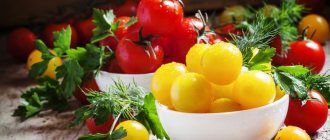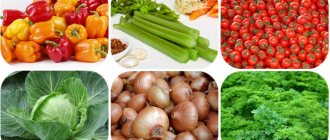return to section
August 25, 2021
7925
August annually brings a tomato boom to our garden beds and market stalls. The tomato has become such an indispensable vegetable for Belarusians that you can see it in almost every dish: from high-calorie bachelor appetizers to salads in which tomatoes are mixed with fruit. But what is the nutritional value of tomatoes? Do they help with weight loss and are pickled tomatoes harmful? Dietitian-nutritionist, leading specialist at the Medical Weight Loss Center Marta Marudova gave us the opportunity to understand these and other questions.
Botanical description
According to the culinary classification, the tomato is a vegetable, and the botanical classification is a berry.
Due to high demand, many varieties of the product have been developed, which differ in: shape (heart-shaped, flattened, round, elongated), color (yellow, orange, pink, red, purple, dark burgundy), surface type (medium ribbed, highly ribbed, smooth , slightly ribbed), weight (from 0.02 kg to 1 kg/1 fruit), duration of the growing season (very early, early, mid-early, late, very late).
The tomato has a monopodial (pivot) root system, which is located in the upper layers of the soil. The stem is covered with hairs, erect or lodging.
According to the height of the plant, the crop is divided into the following types: dwarf (up to 30 cm), low (30-50 cm), medium (50-90 cm), high (90-150 cm), very high (over 150 cm).
The leaves consist of lobes, alternate. The inflorescence is a racemose curl; depending on the variety, it can be polysyllabic, uncomplicated or simple.
The fruit is a watery, juicy berry with small seeds of a triangular-kidney-shaped configuration. The surface, shape and size of a tomato are highly dependent on its growing conditions. Under unfavorable factors, the berry loses its ribbing, becomes rounded, and decreases in size relative to the usual parameters of the variety.
Tomato seeds remain viable for 5-7 years.
Interestingly, the length of the growing season of the plant depends on the territorial location of the site. As the planted fields move from south to north, ripening lengthens. As a result, the shift in the germination period can reach 30 days.
Chemical composition
Tomatoes do not contain starch and cholesterol; they contain virtually no fat, sugar or dietary fiber. Traditionally, the cucumber is considered the most watery vegetable, while the tomato is in no way inferior to it (100 g of product contains 95.28 g of water), therefore it is recommended for use in diets for weight loss. Tomatoes contain an antioxidant (lycopene), which prevents DNA mutations and the growth of cancer cells. In the human body, it is absorbed with vegetable fats (oil).
Energy value, per 100 g of product:
- yellow tomatoes, raw – 15 kcal;
- orange tomatoes, raw – 16 kcal;
- red tomatoes, raw – 18 kcal;
- Cherry tomatoes, raw – 27 kcal.
The energy ratio B: F: Y is 12%: 9%: 84%.
Anthocyanins, abscisic acid, sterols, triterpene saponins were found in the fruits, essential oil and glycoalkaloids (tomatine, tomatidine) were found in the leaves.
The characteristic aroma of tomatoes is given by aldehydes (furfural, benzaldehyde) and volatile alcohols (isovaleric, isobutyl), and their color is given by phenols, anthocyanins, anthoxanthins, lycopene and carotene.
Table No. 1 “Nutritional value of tomatoes by type”
| Components | Content per 100 grams of product, grams | |||
| Yellow | Orange | Reds | "Cherry" | |
| Water | 95,28 | 94,78 | 94,52 | 93,4 |
| Carbohydrates | 2,98 | 3,18 | 3,89 | 3,84 |
| Squirrels | 0,98 | 1,16 | 0,88 | 1,2 |
| Alimentary fiber | 0,6 | 0,8 | 1,1 | 0,81 |
| Ash | 0,4 | 0,59 | 0,4 | 0,4 |
| Organic acids (oxalic, succinic, tartaric, citric, malic) | 0,6 | 0,6 | 0,6 | 0,6 |
| Mono- and disaccharides | 3,5 | 3,2 | 2,63 | 2,01 |
| Fats | 0,28 | 0,18 | 0,2 | 2,02 |
| Lycopene | – | – | 2,573 | 2,16 |
| Lutein+Zeaxanthin | – | – | 0,123 | 0,08 |
Table No. 2 “Chemical composition of tomatoes by type”
| Name | Concentration of nutrients in 100 grams of product, milligrams | |||
| Yellow | Orange | Reds | "Cherry" | |
| Vitamins | ||||
| Ascorbic acid (C) | 9,0 | 15,0 | 13,7 | 24,0 |
| Niacin (B3) | 1,179 | 0,593 | 0,594 | 0,49 |
| Pantothenic acid (B5) | 0,12 | 0,186 | 0,089 | – |
| Pyridoxine (B6) | 0,056 | 0,059 | 0,078 | 0,1 |
| Riboflavin (B2) | 0,047 | 0,034 | 0,019 | 0,039 |
| Thiamine (B1) | 0,041 | 0,046 | 0,037 | 0,06 |
| Folic acid (B9) | 0,031 | 0,029 | 0,015 | 0,0113 |
| Beta carotene (A) | – | 0,075 | 0,449 | 1,2 |
| Choline (B4) | – | – | 6,7 | – |
| Tocopherol (E) | – | – | 0,54 | 0,40 |
| Betaine | – | – | 0,1 | – |
| Phylloquinone (K) | – | – | 0,0079 | – |
| Macronutrients | ||||
| Potassium | 258,0 | 212,0 | 237,0 | 290,7 |
| Phosphorus | 36,0 | 30,0 | 25,0 | 27,0 |
| Calcium | 11,0 | 6,0 | 9,0 | 14,3 |
| Sodium | 23,0 | 41,0 | 6,0 | 39,0 |
| Magnesium | 11,0 | 9,0 | 10,0 | 20,1 |
| Chlorine | – | – | 56,0 | 61,0 |
| Sulfur | – | – | 11,0 | 11,0 |
| Microelements | ||||
| Iron | 0,49 | 0,46 | 0,26 | 0,9 |
| Zinc | 0,28 | 0,13 | 0,18 | 0,2 |
| Manganese | 0,11 | 0,088 | 0,114 | 0,14 |
| Copper | 0,101 | 0,062 | 0,059 | 0,112 |
| Selenium | 0,0004 | 0,0004 | 0,0004 | 0,0004 |
| Fluorine | 0,02 | 0,02 | 0,023 | 0,0201 |
| Molybdenum | 0,007 | 0,007 | 0,007 | 0,007 |
| Cobalt | 0,005 | 0,005 | 0,005 | 0,005 |
| Iodine | 0,002 | 0,002 | 0,002 | 0,0021 |
| Bor | 0,115 | 0,115 | 0,115 | 0,115 |
| Chromium | – | – | – | 0,005 |
More than 60 million tons of tomatoes, 44 million tons of bananas and 36 million tons of apples are grown annually in the world. The largest areas of vegetable plantations are concentrated in China, where the volume of plant cultivation accounts for 16% of total world production. Interestingly, tomatoes contain the “happy hormone” serotonin, which improves mood, and the bulk of ascorbic acid is concentrated around the seeds.
Interestingly, heat treatment (for 2 minutes of cooking) increases the volume of lycopene in tomatoes by 1/3. And red varieties contain more nutrients than yellow ones.
The pulp of ripe fruits contains phytoncides that prevent the development of infection.
Potatoes: you can eat them, but...
“To eat or not to eat?” — women who are losing weight constantly ask this question. If you cook potatoes without oil, they are a fairly low-calorie product: 80 kcal per 100 g. The main problem is that in our country, potatoes are often fried in so much lard and oil that it’s even scary to count calories.
And the puree is usually turned into a “potato shake” with egg, butter, milk or cream. In this form, the glycemic index of the product is higher than that of jacket potatoes or baked in foil. Be sure to eat potatoes, they have a lot of vitamin C, but just cook them correctly. If you make mashed potatoes, use the water in which the potatoes were boiled, and at the end of cooking, add a small amount of oil.
Beneficial features
Fresh tomato juice and pulp puree are prescribed for children, adults and women during pregnancy. This is the best natural source of mineral compounds, vitamins, and dietary fiber. Interestingly, ancient Indian tribes consumed the vegetable to enhance male potency.
Tomato is a home healer used to treat nervous disorders, depression, gastritis with low acidity, diseases of the eyes, skin, upper respiratory tract, wounds, burns, colds, ARVI. And also for the prevention of atherosclerosis, vitamin deficiency, and increased libido.
The vegetable has diuretic, choleretic, anti-inflammatory, and antioxidant properties.
"Power" of tomatoes:
- They lower blood pressure, prevent the formation of blood clots, and normalize the acid-base balance.
- Prevents the growth and decay of cancer cells.
- Improves metabolism and quenches thirst well.
- Normalizes the functioning of the heart, nervous system, and digestion.
- They lift your spirits, support your immune system, and give strength to your body.
- Neutralizes toxins accumulated in the intestines and promotes the elimination of cholesterol.
- Improve the absorption of information, prevent eye diseases.
- Promotes weight loss. Potassium salts reduce the ability of body tissues to retain water. As a result, kilograms disappear along with excess fluid.
Remember, most of the nutrients are contained in the skin of the tomato, so it should not be peeled.
Tomatoes are especially useful for smokers. The biologically active substances included in their composition break down and remove nicotine toxins and tar from the lungs. In addition, they normalize taste and rid teeth of tobacco plaque.
In the absence of contraindications, tomatoes can be included in the daily diet up to 5 pieces.
Due to the rich vitamin and mineral composition, it is recommended to spend fasting days on tomatoes from time to time.
Doctors' prohibitions
Tomato is a widespread product around the world, which is consumed both raw and processed (salted, pickled, dried, fried, baked). Sauces, ketchups, pastas, soups, fillings for pies and pizza are prepared on the basis of the vegetable. However, is this product so harmless? Let's consider this issue in detail.
Tomatoes pose a hidden danger to human health in the following cases:
- In case of individual intolerance. Bright fruits, like citrus fruits, chocolate are the strongest allergens; they can cause hives, sneezing, coughing, swelling, runny nose and pain in the eyes.
- For cholelithiasis. The organic acids contained in tomatoes activate the functioning of the stomach and pancreas, participate in the digestion process, enhance intestinal motility, and have a strong choleretic effect, which can lead to the displacement of stones in the gall bladder and only threatens to worsen the patient’s health.
- For pancreatitis. Tomatoes provoke inflammation of the pancreas. Unripe, green fruits pose the greatest danger to the patient's health.
- For kidney disease. Oxalic acid disrupts water-salt metabolism, which aggravates problems with the genitourinary system. In addition, canned tomatoes contribute to the growth of kidney stones (if there is such a predisposition).
- For gastrointestinal diseases. Gastritis and stomach ulcers, especially in the acute phase, are direct contraindications to eating tomatoes.
- For joint diseases. Oxalic acid concentrated in the fruit causes severe pain in the movable joint of the ends of the bones, so the product is excluded from the patient’s daily menu.
- For hypertension. People with heart problems should exclude pickled, salted and canned tomatoes from their usual diet.
It is not recommended to combine tomatoes with eggs, fish, bread or meat. The minimum break between eating a vegetable and these food products is 2 hours. In addition, food should not be washed down with tomato juice. To avoid dilution of gastric juice and deterioration of food digestion, it is consumed 30 minutes before meals or in between meals.
Possible harm from tomatoes
It should be borne in mind that this product also has a negative quality - it can provoke the development of urolithiasis, especially in that category of people who have a tendency to form kidney stones. Here it would be correct to exclude the consumption of tomatoes or limit them to the maximum.
Also, you should not eat only tomatoes in order to lose unnecessary pounds. This mono-diet is very dangerous. No nutritionist will recommend it.
Experts in this field say that tomatoes contain acids that irritate the intestinal walls. That is, you should not abuse the presented product, especially for people who have problems with the digestive system. In addition, due to the low carbohydrate content and lack of fat, such a tomato diet can cause major problems in the functioning of internal organs.
Metabolism improves when consuming such a light product, but subsequently there is a high probability of difficulty breaking down more high-calorie foods, which will lead to an increase in body weight. Therefore, if the question arises whether it is possible to gain weight from tomatoes, then the answer will definitely be no, but it is not advisable to use them alone for weight loss.
Classification of tomatoes
“Maximum benefits – minimum calories” - this is how nutritionists characterize the herbaceous plant Solanaceae. The low energy value of tomatoes makes it possible to include the product in the diet of people suffering from obesity. Unlike relatives in the family, which accumulate toxic alkaloids in the pulp, tomatoes contain them in smaller quantities (5 times).
Types of tomatoes by shape:
- Fleshy. This is the most delicious type, the distinctive feature of which is the large size of the vegetable. Used for making salads.
- Round. A characteristic feature is the correct shape, which gives the product a beautiful presentation. They are used in cooking for stuffing and preparing dishes that highlight the ideal shape of the vegetable.
- Cream tomatoes. They are medium in size, elongated in shape, and have an exquisite taste. Chefs use the product to make sauces, seasonings and preserves.
- Cherry tomatoes. These are small tomatoes, the size of a nut, which are added whole to salads and appetizers to emphasize the delicacy of the dish. Unlike their larger counterparts, the dry matter content in them is 2 times higher. Thus, when consuming the same amount of ordinary tomatoes and cherry tomatoes, in the second case the human body will receive 2 times more antioxidants, sugars, and vitamins.
Cream tomatoes are valued lower than round representatives of the nightshade family. At the same time, the laurels of primacy belong to small cherry and fleshy varieties, which have an attractive appearance (the first) and an unusually sweet taste (the second).
Variety of tomatoes by ripening time:
- Ultra-early ripening (80-85 days). As a rule, superdeterminate tomatoes belong to this species. The fruit pulp is not sweet due to the fact that the crop grows in short daylight hours.
Ultra-early ripening fruits include the following varieties: Zhavoronok F1, Olya F, Cherry Potok F1, Sanka, Children's sweetness.
- Early ripening (90-95 days). This group includes medium-sized determinate varieties and low standard tomatoes.
Popular hybrids: Leopold F1, Prima Donna F1, Leader of the Redskins, Tsar Bell.
- Mid-early (100-103 days). They are grown under temporary film cover, in a greenhouse or in open ground, placing the beds on the south side of the site. Common varieties: Verlioka plus F1, Moscow delicacy, Blagovest F1, Gigant Podmoskovya.
- Mid-season (100-115 days). To ripen the crop, the fruits require more sunlight than early varieties of tomatoes.
Mid-season varieties include: Siberian Miracle, Uhazher, Budenovka, Koenigsberg, French Grozdevoy, Kostroma F1.
- Late ripening (120-130 days). The best option for growing tomatoes is a greenhouse. Otherwise, when cultivating a plant in open ground, early frosts can lead to crop loss.
Popular varieties: De Barao, Titan, Bull's Heart, Finish, Date, Vladimir F1.
According to their intended purpose, tomatoes are distinguished for fresh consumption (with thin skin, fleshy, juicy, sweet pulp), for processing (they have a dense structure, fleshy with a minimum number of seeds), for canning (with a hard skin, regular shape), universal varieties (possess all listed advantages).
The traditional color of tomatoes is red. Purple, green, orange, yellow, black, white and pink tomatoes are much less common. The following pigments give the characteristic color to the fruits: lycopene, ascorbic acid, alpha and beta carotene, phenols, anthocyanins, anthoxanthins.
The best varieties of tomatoes in terms of taste are “Miracle of the Earth”, “Dina”, “Appetizing”, “Brown Sugar”, “Bull’s Heart” and “Bull’s Brow”.
Tomato: size matters
Tomatoes contain very few carbohydrates: only 5 g per 100 g of product. The vegetable contains lycopene and glutathione - powerful antioxidants that have an immunostimulating and anti-carcinogenic effect. It would seem, why can’t such a healthy delicacy be eaten in large quantities?
If you eat several cherry tomatoes or one hundred-gram tomato, the size of a woman’s fist, nothing will happen, but from a juicy and sweet pink tomato, which weighs 600-800 g, and even eaten every day in the belief that it is healthy, you can get better. Remember: the calorie content and the effect of the product on your weight depend on the amount you eat.
Source
Indeterminate or determinant
The tomato is a herbaceous plant that by its nature can grow as a vine throughout its life. Wild representatives weave around accessible areas in their homeland (America), creeping along the ground. Currently, through selection, cultivated forms with limited growth and high early ripening of fruits have been developed.
Types of tomatoes as they grow:
- Indeterminate (unlimited growth). Tomatoes of this variety are also called liana-shaped or climbing tomatoes. They are cultivated in open and closed ground. The plant continuously grows due to the formation of lateral shoots that extend from the leaf axil. Tall varieties are sown in liter tetra bags, and determinate varieties are sown in wide peat pots.
Liana-shaped tomatoes are usually not early ripening, so they are buried in the soil earlier than others. This variety continuously bears fruit after laying the first cluster for 5 months a year.
Popular varieties: Budenovka, Bull's Heart, Andreevsky Surprise, Pink Magic F1, Babushkin Secret, Giant Raspberry.
- Bush. A distinctive feature of the species is limited growth. The stem of the plant matures, stopping to stretch upward after the formation of three inflorescences between which 1-2 leaves are concentrated. These are fast-growing varieties that are cultivated for a quick harvest.
- Superdeterminate - dwarf plants. They are a branched bush with inflorescences at the top. No more than 3 clusters are formed on the main stem. At the same time, the vegetative growth of the plant is inhibited for a long time.
The fruits of superdeets are the fastest ripening; up to 90% of the entire harvest ripens in 20 days.
Varieties and hybrids: Children's sweetness, Alaska, White filling, Sanka, Betalux, Children's sweetness.
- Determinate ones have an average growth force, which stops after the formation of 5 brushes. Unlike the previous species, the speed of shoot development is more pronounced. Determinate varieties ripen 7 days later than superdeterminant varieties, and the harvest period is considered more extended. Therefore, it is advantageous to plant them in greenhouses, as the space is used more efficiently.
The most common varieties: Ladies' Man, Oak, Sakhalin, Siberian Early, Amur Zarya, Aurora F1, King of the Early, Golden Heart.
A variety of determinate varieties are standard tomatoes, which have a strong stem and low “growth”. They do not require tying up the plant.
The best varieties of tomatoes (standard): Edelrot, Hartzfeuer F1, Moskvich, Snow White, Riddle.
- Semi-determinate - tall tomatoes. The plant has unlimited growth and matures after the formation of 10 inflorescences. These are late-ripening varieties of large sizes.
Popular hybrids: Red Arrow F1, Northern Express F1, Yvette F1.
Today, determinate varieties of tomatoes are the most popular. The positive features of which include: early ripeness, high yield (due to the formation of ovaries due to a smaller number of leaves), simultaneous production of fruits from several clusters at once. Among the disadvantages of this type are: predisposition to diseases, lower overall yield due to limited growth of the clusters, the need to apply mineral fertilizers in increased quantities and remove stepsons (to avoid overloading the crop with ovaries).
Beets: benefit or harm?
Beets are undoubtedly a pioneer in detoxifying the body. In the old days they said: “Eat a bag of beets in a year, and gallbladder diseases will bypass you.” But can everyone eat beets in large quantities? Of course not. Beets contain a considerable amount of carbohydrates: 10 g per 100 g of product. It’s not for nothing that beets are called “sugar beets.” When boiled or baked, the effect of beets on blood glucose levels becomes even higher than when raw. But we mostly eat it thermally processed!
Therefore, we eat beets in measured doses: as part of first courses (not long ago we published a beetroot recipe: Tasty and easy: 3 quick recipes for cold soups), in small quantities (1-2 tablespoons) in a vinaigrette or as a separate component. This is especially true for people with diabetes. Well, I don’t think there’s any need to talk about the fact that “herring under a fur coat” is far from being a dietary salad.
Selection criteria and storage
Due to the wide range of varieties and hybrids of tomatoes on sale, you can get confused in their diversity and, instead of a high yield, get bushes with rotting fruits, drooping under the weight of their own branches. Before purchasing seeds, determine the purpose of cultivating tomatoes: for fresh consumption, transportation to remote regions, processing and storage.
Seed selection criteria:
- productivity;
- regionalization;
- taste qualities;
- disease resistance.
Most gardeners prefer to grow vegetables in greenhouses. This is especially true for areas with short and cold summers (northern regions). For full growth and development of the plant, the width of the greenhouse should not be less than 2 m, and the length – 4 m. At the same time, the distance between the beds should exceed 0.4 m. And its width should be 0.8 m. It is believed that in a greenhouse it is better to grow tall and low growing varieties. With the right combination, the harvest can be obtained within 7 months of the year.
Ways to select tomatoes:
- Estimate the size of the fetus. Avoid large vegetables; most likely, chemical fertilizers were used during their cultivation. Exceptions are varieties with large fruits, weighing up to 0.5 kg - “Pink Giant”, “Beef”, “Bull’s Heart”. In other cases, it is recommended to give preference to medium-sized tomatoes.
- Inspect the membrane of the fruit. It should be uniform in color, shiny and smooth, without stains, cuts or dents. Remember, in places of damage, dirt, dust, and harmful microorganisms can accumulate, which, when they enter the body, disrupt the natural intestinal microflora and the digestive process.
- Inspect the cut of the tomato. If the internal chambers are full and juice appears on its surface, then the tomato is fresh.
- Smell. Green tomatoes have almost no smell, and fruits that exude a delicious juicy aroma are considered ripe.
- Inspect the stalk area. It should be the same color as the entire surface of the tomato. Green and yellow compactions indicate that the fruits were picked in an unripe state. As a result, such a product is deprived of all beneficial properties.
- Check elasticity. Fresh tomatoes are neither hard nor soft to the touch. In the first case, the fruits are considered unripe, in the second - long since picked.
Remember, if the consistency of tomatoes is too soft, it indicates that the product has already begun to rot.
Hard veins from the stalk around the circumference of the tomato, the light green color of the pulp indicate the use of chemical fertilizers in the process of growing the vegetable and the abundance of nitrates in their composition. Avoid purchasing such a product.
Ground tomatoes are considered the most useful, containing a maximum of beneficial nutrients.
Tomatoes are stored in a dark place at a temperature of 20-25 degrees for a maximum of 3 days. Otherwise, they will become overripe, become soft and begin to rot. Vegetables placed in the refrigerator lose their flavor. However, their shelf life increases to one week. Unripe tomatoes are stored in a paper bag along with apples.
To increase the shelf life of a large batch of tomatoes, vegetables are stored in boxes and boxes with the stalks facing up, each row covered with sawdust, straw or burlap. The ideal storage temperature for the product is 10 degrees above zero. If the indicator decreases, the fruits may become sick and become moldy; if the indicator increases, the fruits may become overripe and spoil. In addition, you should ensure good air circulation in the room. Compact-sized fruits with thick skin are best preserved.
Avocado and olives: what to do?
I would especially like to draw attention to avocados and olives. These are very healthy, but high-calorie gifts of nature. The calorie content of an avocado is 200 kcal and 20 g of fat per 100 grams (the weight of an average pitted fruit is about 150 g). I call it “vegetable sour cream” because the caloric content of sour cream with 20% fat content is exactly the same amount of kilocalories and fat.
1 olive weighs about 3 g, but it contains 5 kcal and 0.5 g of fat. Therefore, these vegetables in the diet should be presented as an addition to any dish. If you eat avocados, like apples, several a day, and olives, like cucumbers, then very soon you will notice an increase in fat deposits on your stomach or sides.
Use in folk medicine
Tomato is a good diuretic that eliminates diseases of the bladder and kidneys, it improves the functioning of the heart, reduces the likelihood of heart attack and stroke, and prevents atherosclerosis. The nutritional value of the fruit is determined by the content of lycopene, vitamins B, C, K, PP.
Interestingly, 100 g of tomatoes contains 2-3 times more iron than fish, chicken and milk. At the same time, people with gastrointestinal diseases accompanied by hypersecretion of hydrochloric acid should avoid eating tomatoes since the acid they contain has a corrosive effect on the mucous membranes of the digestive organs. This feature of tomatoes is used on the farm for cleaning plumbing fixtures.
Homemade recipes to stay healthy:
- To improve metabolism. Ingredients: fresh tomatoes (1 kg), Antonov apples (300 g), garlic (2 cloves), horseradish (100 g). Grind all components. Take 30 ml of the pulp on an empty stomach.
- Against anemia. Red tomatoes are a source of ascorbic acid and lycopene. These compounds improve the absorption of iron, which is involved in hematopoiesis. To combat anemia, it is recommended to take 150 ml of freshly squeezed tomato juice daily 10 minutes before meals.
- For the treatment of respiratory tract diseases, cough elimination. Ingredients: garlic (50 g), horseradish root (100 g), fresh tomatoes (1 kg). Grind all components until smooth using a blender. Directions for use: 15 ml 3 times a day 20 minutes before meals.
- Against varicose veins. To eliminate pain and bluish spots, fresh tomato slices are applied to swollen veins as a compress. The vegetable is fixed with a bandage, the bandage is left for 3 hours. After the specified time has passed, rinse your feet with cool water. Carry out the procedure daily until a lasting result is obtained.
- Against purulent wounds and abscesses. Tomato pulp accelerates wound healing. In addition, the fruits are credited with an antiseptic effect. According to clinical studies, it has been established that phytoncides contained in tomatoes inhibit the growth of pyogenic bacteria. The fruit pulp is ground into a homogeneous paste and applied to a wound, ulcer, or abscess for 15 minutes, then removed with distilled water.
American scientists have concluded that the most effective natural way to protect against cancer is to eat a salad of fresh tomatoes and broccoli every day. The products contain substances that inhibit the growth and prevent the decay of malignant cells.
Do tomatoes make you fat?
There is also the question of why people get fat from this vegetable. In this case, the formation of extra pounds does not come from the tomatoes themselves, but from the way they are consumed. That is, mayonnaise or sour cream is used as a dressing for tomato salads or they are fried in oil, during which carcinogens are formed that negatively affect human health.
Eating tomatoes with a huge amount of bread and heavily flavored with spices and salt also contributes to weight gain.
It is these points that can lead to weight gain, and not the tomatoes themselves that provoke this process.
Today, there are a large number of different diets based on this vegetable, which effectively eliminate additional weight and also allow you to maintain the balance of vital elements in the body.
Benefits for the skin
A tomato mask improves complexion, softens the dermis, gives it elasticity and freshness, and eliminates oily shine. The beneficial properties of fruits depend on their degree of ripeness. For cosmetic procedures, it is recommended to use ripe red, pink or yellow tomatoes. They contain maximum vitamins. Phytoncides contained in tomato pulp fight inflammation caused by rashes and allergic reactions. And zinc prevents skin aging, increasing the ability of the epidermis to regenerate.
Mask recipes:
- For normal skin (nourishing). Ingredients: pulp of one tomato, chicken yolk, flour. Mix until a homogeneous thick mass is obtained. Apply the mask to your face for 10 minutes, rinse off.
Another recipe for preparing a nourishing mask: mix grated tomato mass (from 1 fruit) with grape juice (30 ml), warm boiled water (15 ml), honey (15 ml). Leave the mask on the skin for 10 minutes, remove any residue with a napkin, and wipe your face with toner.
- For dry skin (moisturizing). Ingredients: cottage cheese 20% (15 g), tomato (0.5 pcs), whole cow's milk (30 ml), olive oil (5 ml). Grind the ingredients well, apply the product to the skin for a quarter of an hour, and wash.
- For oily skin (tightens pores). Ingredients: tomato (1 pc), lemon juice (5 ml), flour (15 g). Mix the components of the mask, apply to the face, and rinse with water.
- Belongings (to cleanse the dermis of keratinized particles). Ingredients: sour milk (15 ml), “tomato porridge” (from 1 fruit), olive oil (4 drops), ground oatmeal (15 g). Mix the scrub components thoroughly, apply to the skin, massage it thoroughly, and rinse with water.
In addition, a refreshing lotion is prepared from tomato juice from distilled water (70 ml), alum (2 g), tomato squeeze (30 ml), glycerin (5 ml) to reduce skin sweating. The toner is recommended to be applied to cleansed facial skin in the summer.











